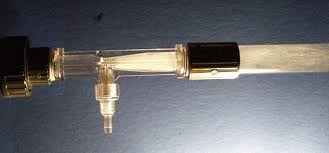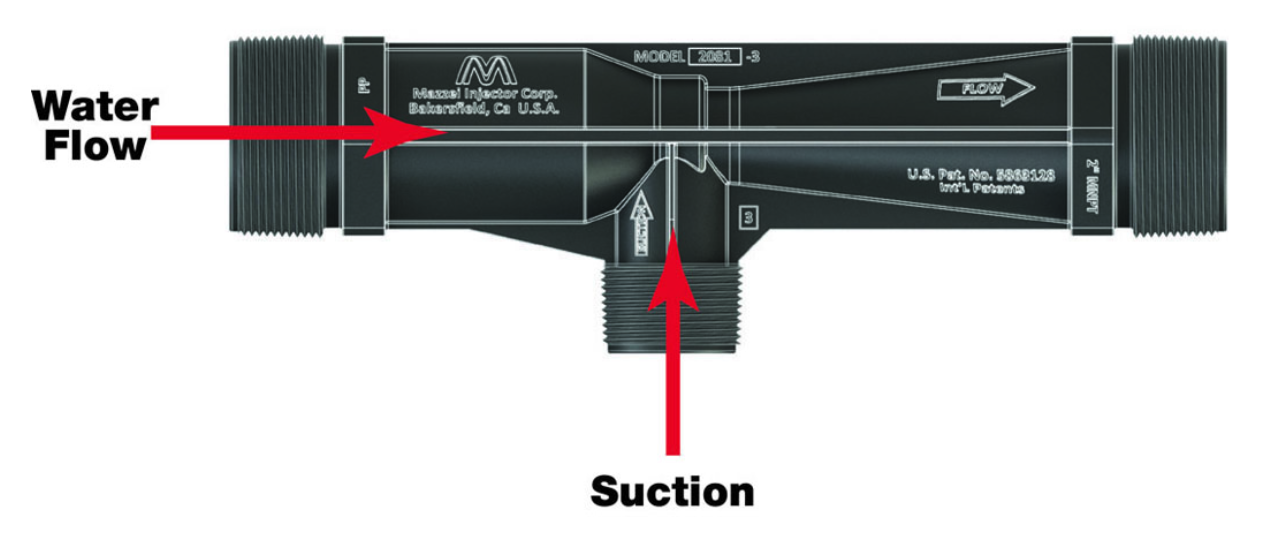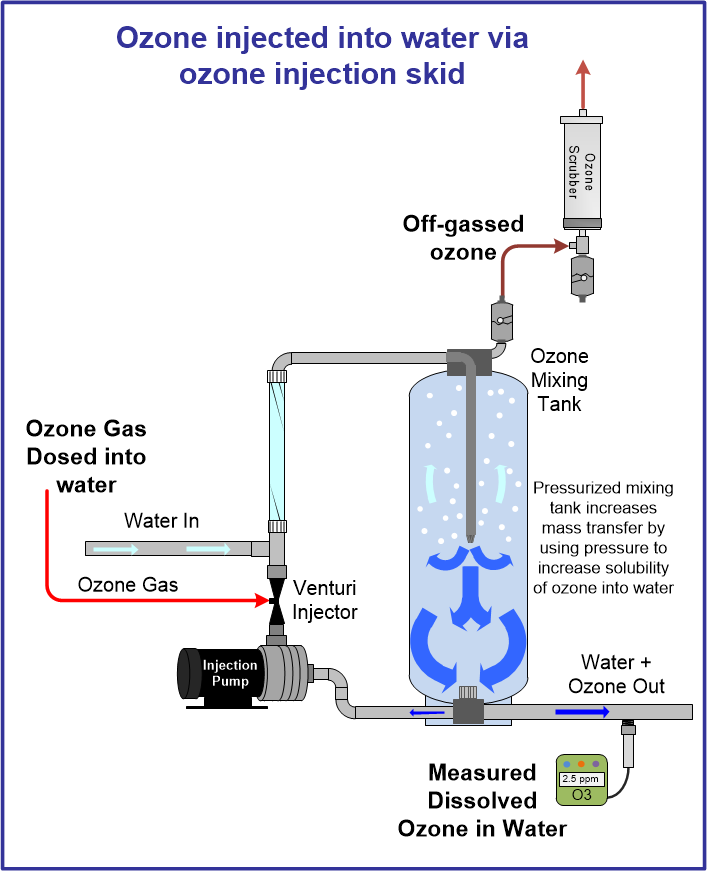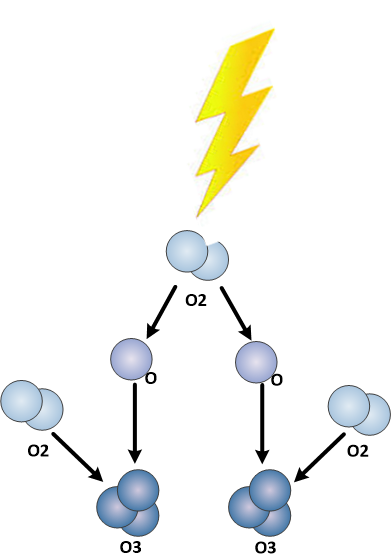Ozone dissolved with Venturi Injector
Ozone gas can be dissolved into flowing water via a venturi injector. A venturi injector is typically up to 90% efficient and can be up to 99% efficient at dissolving ozone into water making this the most common and preferred method for ozone injection.
A venturi injector uses a pressure differential across a small orifice with an off-set opening and a suction port. Ozone gas is pulled into the water via the suction port of the venturi. Due to the pressure change and forces present the ozone gas dissolves into the liquid extremely quickly, and efficiently.

To use a venturi injector water must be flowing and water pressure must be present with the ability to drop pressure at the discharge of the venturi injector. Water may already be flowing from another source to provide the flow and pressure, or a dedicated water pump can be provided to provide the flow and pressure needed for the venturi injector.

Advantages:
- Extremely efficient
- Great option for pressurized water
- More ozone dissolved into water = less ozone off-gassing = safer environment
- Easier to contain ozone gas and maintain a safe environment due to ozone off-gassing
Disadvantages:
- Typically requires more energy than other options due to required pressure differential across venturi injector
- Requires flowing, pressurized water
- Greater risk of water backing up into the ozone generator as the water is pressurized
- Venturi can plug or become obstructed in contaminated water
Ozone gas is partially soluble into liquid. However, using proper methods and equipment high mass transfer efficiencies can be realized with any method of dissolving ozone into water. Review the tips below to help design a proper system using a venturi injector in your ozone application.
Fundamentals of Ozone Solubility:
-Lower temperatures increase the solubility rate of ozone gas into liquid
-Higher pressures increase the solubility rate of ozone gas into liquid
-Higher ozone gas concentrations increase the solubility rate of ozone gas into liquid
Note:
We exclusively use the Mazzei Venturi Injector manufactured by Mazzei injector Co. All performance chart and venturi suggestions are based on the Mazzei Venturi Injector.
Design considerations for your ozone system using a venturi injector:
Sizing Venturi Injector properly:
Venturi Injectors are available in a wide variety of sizes to meet a wide variety of water pressures and flow-rates. Using the right Venturi Injector for your application is paramount for a successful application.
Each Venturi Injector is provided with a performance chart showing the expected water flow-rate, water pressure, and correlating suction rate based on discharge pressure. Use this to determine the right size venturi for your water flow-rate and/or gas suction needs.
See our article HERE on reading Venturi Injector performance charts.
General Venturi Injector Installation Tips:
- Venturi injectors should always be installed in either a horizontal position or vertical position with the outlet above the inlet (water flowing upward). Never install with the inlet above the outlet as it may cause erratic suction
- Always install piping after the venturi before flowing water into a tank. At least 12” of piping should be used at the venturi outlet
- Never restrict the venturi outlet, consider using larger tubing at the venturi outflow than inflow as the pipe will be filled with both the water and added gas that has been pulled into the venturi.
- For best performance target a 20 PSI pressure differential or greater between the venturi inlet and outlet
- Install pressure gauges on tee’s directly at the venturi inlet and outlet to verify water pressures
Gas to Liquid Ratio:
Gas to liquid ratio refers to the volume of gas added to the volume of liquid. The less gas dissolved into liquid will inherently increase your solubility rate of that gas into liquid.
For example, consider the following examples, using LPM (liters per minute) for simplicity:
- 1 LPM of gas dissolving into 100 LPM of liquid. This volume of gas would easily dissolve into the liquid
- 50 LPM of gas dissolving into 100 LPM of liquid. While possible, it would be more challenging to dissolve this amount of gas into liquid.
Certainly the lowest gas:liquid ratio is ideal. We suggest maintaining a gas:liquid ratio of 0.5 or 1:2 meaning 50 LPM of gas dissolving into 100 LPM of liquid is the greatest amount of gas one should dissolve into that liquid flow.
Pressure - More is better:
Ozone solubility is the rate at which ozone can be dissolved into liquid. Think of it as a theoretical maximum. The solubility of ozone gas into liquid us affected greatly by the pressure of the water, among other factors.
To learn more about ozone solubility, click HERE
The chart and table below illustrate the solubility of ozone gas into water as it relates to the pressure of that water.


As is illustrated, water pressure makes a dramatic difference to the rate at which ozone gas dissolved into water. This pressure would be the pressure at the outlet of the venturi injector. Keep in mind, higher venturi outlet pressures will require higher venturi inlet pressures.
Sealed systems are possible, and preferred:
A great advantage of the venturi injector vs a bubble diffuser is the system can more easily be sealed with a pressurized ozone mixing tank. This allows for two great advantages
-
Increased ozone solubility into liquid due to a pressurized system and mixing tank
-
Ozone off-gas can be contained easily and vented safely to an ozone scrubber
See diagram below for an example of how a system could be set-up to achieve these goals.

In this system, water flows through the ozone mixing tank under pressure to the point of use. The ozone injection pump circulates water on this tank and flows was through a venturi creating the necessary pressure differential for ozone injection. Water is under pressure in the ozone mixing tank, thereby increasing ozone solubility into water. Excess ozone is captured through the air-vent and safely vented directly to an ozone scrubber.
Correct gas flow-rate into venturi injector for pressurized gasses:
The Venturi Injector can create suction to pull gasses into water under vacuum. However, pressurized gasses may also be used to flow into the venturi for gas to liquid mixing. This is especially useful if suction created with the venturi is insufficient to achieve the desired gas flows.
Gas flow for a pressurized gas flow into the venturi can be corrected for and calculated based on the info below:
GP = Gas Pressure (PSIG)
Suction Capacity Correction = ((GP+14.7)/14.7)2
Example:
Gas pressure = 5 PSIG
((5+14.7)/14.7)2 = 1.8x listed performance chart suction
Water back-flow prevention:
While the venturi creates gas suction when water is flowing properly, there are times the gas suction line can flood with water and back-flow water into the ozone generator.
-
When the water flow is turned OFF but the venturi is under water pressure (see above drawing of sealed system for an example)
-
The venturi may malfunction and have an obstruction or other issue causing water to flow upstream in the gas line
While a check valve is provided on the Mazzei venturi injector from the factory, we suggest adding additional water back-flow prevention to ensure water cannot flow from the venturi to the ozone generator. Additional check valves can be used, electric ball valves, or water trapping devices that will trap and drain water from the water line. Whatever you choose, test and/or replace it frequently to ensure there is no chance that water can enter your ozone generator cell.
Also, all check valves fail. One check valve is never sufficient, and check valves alone are typically not sufficient.
Additional Information Links:
Ozone Dosage vs Dissolved Ozone
Dissolve Ozone into water with Bubble Diffuser
Dissolve Ozone into water with Venturi Injector
Dissolve ozone into water with Static Mixer
Compare Venturi Injector and Bubble Diffusers












